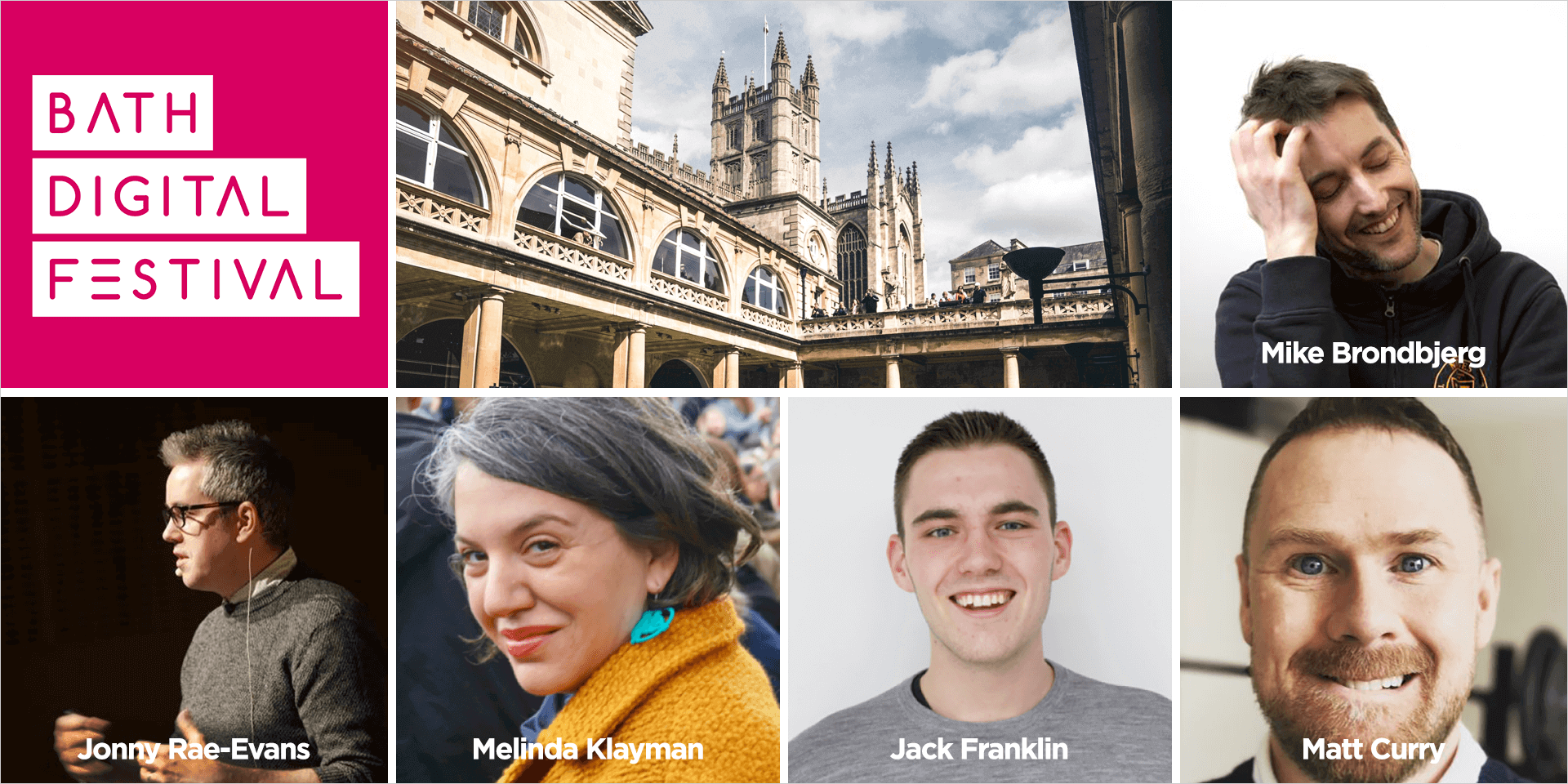With being a team member at WebBox there come several benefits, a particular favourite of mine is the opportunity to attend industry events which helps me keep abreast of technology and learn new skills.
When I saw Bath Digital Festival being advertised I jumped at the opportunity as the week-long event celebrates all things digital including emerging technology which I have a personal interest in.
The article beneath captures snippets of some of the many, many highlights I encountered throughout the event I attended, ‘All Dayer for Web Makers’, Friday 26th October 2018.
Jonny Rae-Evans, Head of Product Innovation at Big Lottery Fund
‘Designing for Good and the Subtle Art of Not Killing Anyone’.
An interesting talk in how Jonny, discussed the power of ethical design or as the topic is commonly referred to ‘Tech for good’. As part of the talk, he explored how to approach designing for vulnerable people.
Items I noted and found of interest included:
- Tech For Good Live podcasts in which a bunch of best friends in the tech for good and pro-social sector gather around a table, drink a bit too much, and talk about what is new in the tech for good scene
- how the term ‘user’ can often be thought of as dehumanising
- to think of the impact you (as a designer) have with your solutions on the people they directly affect
- to immerse yourself fully within a project and truly care about the end outcome
- to bear in mind that design can be emotive
- to constantly challenge decisions — ask why?
- think about who you are making items for and how does it affect people
- to realise that designers are not experts in everything and by not asking the right questions you can create more problems rather than solving them. An anecdote given was in regard to sex workers and how victims were more upset by theft than being raped or assaulted
- how the Big Lottery Fund approaches website development with a red and blue team being created: the blue team are the original developers with the red team trying their best to find flaws.
Melinda Klayman, UX Researcher at Google Search
‘Understanding Your Next Billion Users’
A fascinating talk, in which Melinda showed her findings for where the next billion people were coming from online. These essentially were grouped into:
- Emerging countries/markets
- Emerging social groups
- Emerging adults.
Items I noted and found of interest included:
- the 10 major emerging countries/markets were defined as Argentina, Brazil, China, India, Indonesia, Mexico, Poland, South Africa, South Korea and Turkey
- emerging social groups were defined as women from the Middle East and India, disabled and illiterate
- emerging adults were defined as digital natives (familiar with computers and the Internet from an early age)
- a website called ‘Dollar Street’ which shows how people really live in 50 countries through 30,000 photos
- India in 2017 had 400m online which in 2018 is estimated to be 500m
- India has the 2nd largest number of internet users in the world
- India has a population of 1.25 billion
- Half of the Indian population will be classified as middle class by 2025
- 85% of the Indian banknotes were demonetised in 2016
- In India, e-wallets are increasingly popular with a less cash-based economy
- Jio, the Indian mobile network operator company enables all you can eat data for cheap rates
- 85% of the Indian currency was demonetised
- India has a mobile-first culture, desktop computers are rare with a reliance on cheap mobile phones with old operating systems limited in power with slow network connections
- to think about graceful degradation and offline solutions
- Indian mobile stores pre-set up devices with Facebook, WhatsApp and YouTube with English as the primary language
- 30% of the current 400m online users are women who generally obtain their phones from hand me downs and have a lower literacy than men
- the ability to access the internet empowers women, providing independence
- Indian families tend to share phones and don’t use locks as it’s considered naughty
- decoy apps are popular as they can hide items e.g. private photographs
- India has 22 major languages, written in 13 different scripts, with over 720 dialects
- Indians tend to use Voice more than keyboards due to literacy.
Jack Franklin, Front-end Engineer at Thread
‘A red LEGO brick is always red: components on the web’
A talk which discussed how thinking of a web application as a tree of components, rather than discrete pages, leads to a more testable, maintainable and reliable codebase.
Items I noted and found of interest included:
- React — a JavaScript library for building user interfaces/component libraries
- Elm — a programming language to create reliable web apps
- creating a general codebase which contains reusable components
- splitting components into logic and presentation
- configurable attributes for components making them truly bespoke
- the rule at Thread is only to have 3 maximum configurable attributes per component
- every component should have its own styling and classes
- Webpack — an online tool which creates random CSS class names, helpful for component creation
- JS Playground — the personal website of Jack Franklin which contains his latest tutorials, screencasts and more
- Setting CSS styles using JavaScript.
Matt Curry, Head of E-commerce at Lovehoney
‘Thank you for your custom, please come again’
Within this session, Matt talked through how data sells sex, how to move from user research to hypothesis and testing, how to plan a conversion strategy, looking beyond the data into customer motives and patterns, and how he’s taken a Data Science driven approach to make a user’s journey at Lovehoney truly satisfying.
Items I noted and found of interest included:
- Snowplow Analytics — an app which gives you control of your own data, setting your team free to use data to be transformative
- Adobe Analytics — the industry-leading solution for applying real-time analytics & segmentation
- Ometria — the customer marketing platform for retail
- Google Data Studio — an app which enables you to turn your client’s analytics data into informational, easy-to-understand reports through data visualisation
- how data should inform the design process
- assumptive mapping (guessing a user journey) vs experience mapping (user research)
- how videos of products at Lovehoney were proven to increase sales
- make analytics actionable.
Mike Brondbjerg, Information Designer and Data Visualisation Developer at Kultur Design
‘Using Data as a Creative Material’
Mike’s talk was of particular interest to me (being a Designer) as it was more of a visual experience showcasing how data can be transformed into beautiful, creative imagery.
Items I noted and found of interest included:
- Space Oddity — a project which visualises data from Bowie’s 1969 track Space Oddity on a series of 10 specially engraved records with accompanying posters, plus a moving image piece
- Volanti Imaging — the logo used within this project was created algorithmically in Processing and ThreeJS
- London Air Data — a project to visualise the rise & fall of Nitrogen Dioxide levels across London over 1 year
- Dead Presidents — a generative illustration project using a custom drawing algorithm in Processing, to recreate well known classic US presidential Portraits.
- Dear Data — a year-long, analogue data drawing project by Giorgia Lupi and Stefanie Posavec, two award-winning information designers living on different sides of the Atlantic
- p5.js — a JS client-side library for creating graphics and interactive experiences, based on the core principles of Processing
- dc.js — a dimensional charting Javascript library
- three.js — a Javascript 3D library
- Datawrapper — easy to create beautiful charts
Conclusion
I left Bath Digital Festival inspired and informed, armed with a wealth of information, helping me become more aware of the technologies that exist and are emerging.
I’d highly recommend the week-long event to anyone, whether you’re a Designer, Programmer or Marketeer, BDF caters for your every need. But the event isn’t just confined to professionals as there are also other fascinating things you can encounter aimed at families and techies e.g. the ‘Interactive Augmented Reality Tours of Bath’. I look forward to attending next year and seeing the next advances in technology.


